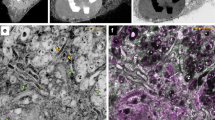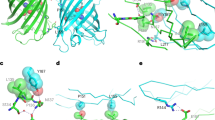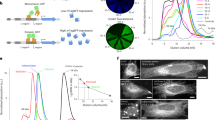Abstract
Fluorescent fusion proteins have revolutionized examination of proteins in living cells. Still, studies using these proteins are met with criticism because proteins are modified and ectopically expressed, in contrast to immunofluorescence studies. However, introducing immunoreagents inside cells can cause protein extraction or relocalization, not reflecting the in vivo situation. Here we discuss pitfalls of immunofluorescence labeling that often receive little attention and argue that immunostaining experiments in dead, permeabilized cells should be complemented with live-cell imaging when scrutinizing protein localization.
This is a preview of subscription content, access via your institution
Access options
Subscribe to this journal
Receive 12 print issues and online access
$259.00 per year
only $21.58 per issue
Buy this article
- Purchase on Springer Link
- Instant access to full article PDF
Prices may be subject to local taxes which are calculated during checkout




Similar content being viewed by others
References
Giepmans, B.N., Adams, S.R., Ellisman, M.H. & Tsien, R.Y. The fluorescent toolbox for assessing protein location and function. Science 312, 217–224 (2006).
Schermelleh, L., Heintzmann, R. & Leonhardt, H. A guide to super-resolution fluorescence microscopy. J. Cell Biol. 190, 165–175 (2010).
Humbel, B.M., de Jong, M.D., Muller, W.H. & Verkleij, A.J. Pre-embedding immunolabeling for electron microscopy: an evaluation of permeabilization methods and markers. Microsc. Res. Tech. 42, 43–58 (1998).
Giepmans, B.N., Deerinck, T.J., Smarr, B.L., Jones, Y.Z. & Ellisman, M.H. Correlated light and electron microscopic imaging of multiple endogenous proteins using Quantum dots. Nat. Methods 2, 743–749 (2005).
Shaner, N.C., Steinbach, P.A. & Tsien, R.Y. A guide to choosing fluorescent proteins. Nat. Methods 2, 905–909 (2005).
Tsien, R.Y. The green fluorescent protein. Annu. Rev. Biochem. 67, 509–544 (1998).
Chudakov, D.M., Matz, M.V., Lukyanov, S. & Lukyanov, K.A. Fluorescent proteins and their applications in imaging living cells and tissues. Physiol. Rev. 90, 1103–1163 (2010).
Palmer, A.E., Qin, Y., Park, J.G. & McCombs, J.E. Design and application of genetically encoded biosensors. Trends Biotechnol. 29, 144–152 (2011).
Piehl, M. & Cassimeris, L. Organization and dynamics of growing microtubule plus ends during early mitosis. Mol. Biol. Cell 14, 916–925 (2003).
Melan, M.A. Overview of cell fixatives and cell membrane permeants. Methods Mol. Biol. 115, 45–55 (1999).
Howell, B., Deacon, H. & Cassimeris, L. Decreasing oncoprotein 18/stathmin levels reduces microtubule catastrophes and increases microtubule polymer in vivo. J. Cell Sci. 112, 3713–3722 (1999).
Hoetelmans, R.W. et al. Effects of acetone, methanol, or paraformaldehyde on cellular structure, visualized by reflection contrast microscopy and transmission and scanning electron microscopy. Appl. Immunohistochem. Mol. Morphol. 9, 346–351 (2001).
Stadler, C., Skogs, M., Brismar, H., Uhlen, M. & Lundberg, E. A single fixation protocol for proteome-wide immunofluorescence localization studies. J. Proteomics 73, 1067–1078 (2010).
Wang, D.S., Miller, R., Shaw, R. & Shaw, G. The pleckstrin homology domain of human beta I sigma II spectrin is targeted to the plasma membrane in vivo. Biochem. Biophys. Res. Commun. 225, 420–426 (1996).
Jamur, M.C. & Oliver, C. Cell fixatives for immunostaining. Methods Mol. Biol. 588, 55–61 (2010).
Jamur, M.C. & Oliver, C. Permeabilization of cell membranes. Methods Mol. Biol. 588, 63–66 (2010).
Hannah, M.J., Weiss, U. & Huttner, W.B. Differential extraction of proteins from paraformaldehyde-fixed cells: lessons from synaptophysin and other membrane proteins. Methods 16, 170–181 (1998).
Goldenthal, K.L., Hedman, K., Chen, J.W., August, J.T. & Willingham, M.C. Postfixation detergent treatment for immunofluorescence suppresses localization of some integral membrane proteins. J. Histochem. Cytochem. 33, 813–820 (1985).
Neuhaus, E.M., Horstmann, H., Almers, W., Maniak, M. & Soldati, T. Ethane-freezing/methanol-fixation of cell monolayers: a procedure for improved preservation of structure and antigenicity for light and electron microscopies. J. Struct. Biol. 121, 326–342 (1998).
Schimenti, K.J. & Jacobberger, J.W. Fixation of mammalian cells for flow cytometric evaluation of DNA content and nuclear immunofluorescence. Cytometry 13, 48–59 (1992).
Hoetelmans, R.W., van Slooten, H.J., Keijzer, R., van de Velde, C.J. & van Dierendonck, J.H. Routine formaldehyde fixation irreversibly reduces immunoreactivity of Bcl-2 in the nuclear compartment of breast cancer cells, but not in the cytoplasm. Appl. Immunohistochem. Mol. Morphol. 9, 74–80 (2001).
Brock, R., Hamelers, I.H. & Jovin, T.M. Comparison of fixation protocols for adherent cultured cells applied to a GFP fusion protein of the epidermal growth factor receptor. Cytometry 35, 353–362 (1999).
Pollice, A.A. et al. Sequential paraformaldehyde and methanol fixation for simultaneous flow cytometric analysis of DNA, cell surface proteins, and intracellular proteins. Cytometry 13, 432–444 (1992).
Hirata, M. & Okamoto, Y. Enumeration of terminal deoxynucleotidyl transferase positive cells in leukemia/lymphoma by flow cytometry. Leuk. Res. 11, 509–518 (1987).
Melan, M.A. & Sluder, G. Redistribution and differential extraction of soluble proteins in permeabilized cultured cells. Implications for immunofluorescence microscopy. J. Cell Sci. 101, 731–743 (1992).
Ohsaki, Y., Maeda, T. & Fujimoto, T. Fixation and permeabilization protocol is critical for the immunolabeling of lipid droplet proteins. Histochem. Cell Biol. 124, 445–452 (2005).
Nakamura, F. Biochemical, electron microscopic and immunohistological observations of cationic detergent-extracted cells: detection and improved preservation of microextensions and ultramicroextensions. BMC Cell Biol. 2, 10 (2001).
Burry, R.W. Controls for immunocytochemistry: an update. J. Histochem. Cytochem. 59, 6–12 (2011).
Mao, S.Y., Javois, L.C. & Kent, U.M. Overview of antibody use in immunocytochemistry. Methods Mol. Biol. 115, 3–10 (1999).
Guillot, P.V., Xie, S.Q., Hollinshead, M. & Pombo, A. Fixation-induced redistribution of hyperphosphorylated RNA polymerase II in the nucleus of human cells. Exp. Cell Res. 295, 460–468 (2004).
Shibata, T., Tanaka, T., Shimizu, K., Hayakawa, S. & Kuroda, K. Immunofluorescence imaging of the influenza virus M1 protein is dependent on the fixation method. J. Virol. Methods 156, 162–165 (2009).
Kanda, T., Sullivan, K.F. & Wahl, G.M. Histone-GFP fusion protein enables sensitive analysis of chromosome dynamics in living mammalian cells. Curr. Biol. 8, 377–385 (1998).
Nasi, S., Cirillo, D., Naldini, L., Marchisio, P.C. & Calissano, P. Microtubules and microfilaments in fixed and permeabilized cells are selectively decorated by nerve growth factor. Proc. Natl. Acad. Sci. USA 79, 820–824 (1982).
Vielkind, U. & Swierenga, S.H. A simple fixation procedure for immunofluorescent detection of different cytoskeletal components within the same cell. Histochemistry 91, 81–88 (1989).
Smith-Clerc, J. & Hinz, B. Immunofluorescence detection of the cytoskeleton and extracellular matrix in tissue and cultured cells. Methods Mol. Biol. 611, 43–57 (2010).
Osborn, M., Fanke, W.W. & Weber, K. Visualization of a system of filaments 7–10 nm thick in cultured cells of an epithelioid line (Pt K2) by immunofluorescence microscopy. Proc. Natl. Acad. Sci. USA 74, 2490–2494 (1977).
Tanaka, K.A. et al. Membrane molecules mobile even after chemical fixation. Nat. Methods 7, 865–866 (2010).
Giepmans, B.N. Bridging fluorescence microscopy and electron microscopy. Histochem. Cell Biol. 130, 211–217 (2008).
Leong, A.S. Pitfalls in diagnostic immunohistology. Adv. Anat. Pathol. 11, 86–93 (2004).
Maurisse, R. et al. Comparative transfection of DNA into primary and transformed mammalian cells from different lineages. BMC Biotechnol. 10, 9 (2010).
Simpson, J.C., Wellenreuther, R., Poustka, A., Pepperkok, R. & Wiemann, S. Systematic subcellular localization of novel proteins identified by large-scale cDNA sequencing. EMBO Rep. 1, 287–292 (2000).
Pepperkok, R., Simpson, J.C. & Wiemann, S. Being in the right location at the right time. Genome Biol. 2, 1024.1–1024.4 (2001).
Rothbauer, U. et al. Targeting and tracing antigens in live cells with fluorescent nanobodies. Nat. Methods 3, 887–889 (2006).
Hageman, J., Vos, M.J., van Waarde, M.A. & Kampinga, H.H. Comparison of intra-organellar chaperone capacity for dealing with stress-induced protein unfolding. J. Biol. Chem. 282, 34334–34345 (2007).
Acknowledgements
We thank H. van der Want and D. Hoekstra for critically reading the manuscript, A. Algra and R. Hoffmann for technical assistance, O. Sibon for H2B cDNA, H. Kampinga for expression constructs44 used in Figure 2c (University Medical Center Groningen) and V. Cirulli (University of Washington) for EpCAM cDNA. Part of this work was supported by the Groningen University Graduate School of Medical Sciences; a Marie Curie International Reintegration Grant within the 7th European Community Framework Program to B.N.G.G. and was performed at the University Medical Center Groningen Microscopy and Imaging Center, which is sponsored by Netherlands Organization for Scientific Research grants 40-00506-98-9021 and 175-010-2009-023.
Author information
Authors and Affiliations
Corresponding author
Ethics declarations
Competing interests
The authors declare no competing financial interests.
Supplementary information
Supplementary Text and Figures
Supplementary Figures 1–9 and Supplementary Methods (PDF 3649 kb)
Rights and permissions
About this article
Cite this article
Schnell, U., Dijk, F., Sjollema, K. et al. Immunolabeling artifacts and the need for live-cell imaging. Nat Methods 9, 152–158 (2012). https://doi.org/10.1038/nmeth.1855
Published:
Issue Date:
DOI: https://doi.org/10.1038/nmeth.1855
This article is cited by
-
Image restoration of degraded time-lapse microscopy data mediated by near-infrared imaging
Nature Methods (2024)
-
Nanoscale imaging of CD47 informs how plasma membrane modifications shape apoptotic cell recognition
Communications Biology (2023)
-
Oncoprotein SET dynamically regulates cellular stress response through nucleocytoplasmic transport in breast cancer
Cell Biology and Toxicology (2023)
-
Glyoxal acid-free (GAF) histological fixative is a suitable alternative to formalin: results from an open-label comparative non-inferiority study
Virchows Archiv (2023)
-
Improved clearing method contributes to deep imaging of plant organs
Communications Biology (2022)



